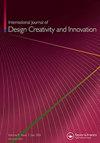Nascent directions for design creativity research
IF 2.5
Q4 ENGINEERING, MANUFACTURING
International Journal of Design Creativity and Innovation
Pub Date : 2020-07-02
DOI:10.1080/21650349.2020.1767885
引用次数: 6
Abstract
Design is recognized as one of the creative professions but that does notmean that design equals creativity. Much of design is not creative, rather it is routine in the sense that the designs produced are those that are similar to existing designs and are only unique in terms of the situation they are in. However, there is value in producing designs that are considered creative in that they add significant value and change people’s perceptions and, in doing so, have the potential to change society by changing its value system. A search for the terms ‘design’ and ‘creativity’ in books over the last 200 years (using Google’s Ngram) shows that the term “design’ was well established by 1800 and its use dropped between 1800 and 1900, after which its use increased to 2000. The term ‘creativity’ only came into noticeable use from 1940 on (Figure 1). It is, therefore, not surprising that creativity research is a young field. Much of early design creativity research has focused on distinguishing design creativity from designing; typically, by attempting to determine when and how a designer was being creative while they were designing. This still remains an important area of design creativity research that deserves considerable attention. Much of the design creativity research over the last 30–40 years has focused on either cognitive studies of designers or on building computational models of creative processes, generally using artificial intelligence or cognitive models. As in other areas of design research, there has been interest in developing cognitive creativity support tools. These two paradigmatic approaches have yielded interesting and important results. Tools can be categorized along a spectrum from passive through responsive to active. Passive tools need to be directly invoked by the designer and remain unchanged by their use. A spreadsheet is an exemplary example of a general passive tool. Passive tools that support design creativity include, for example, morphological analysis and TRIZ. Responsive tools need to be directly invoked by the designer but are changed by their use and do so by learning (Gero, 1996). They aim to tailor their response to the user over time. They tend to be developed for a specific purpose and are often proprietary. Active tools interact with the designer, i.e., they respond to what the designer is doing and make proposals. More recently, there has been interest in studying creativity when the designer is using responsive and active creativity aids. These aids cover a wide spectrum. Here two new categories will be considered: artificial intelligence that supports co-creation and neuro-based creativity enhancement. These two approaches form the basis of two nascent directions that are fundamentally different to the current directions of cognitive studies and passive cognitive support tools. In addition, there have been studies with drugs that affect the brain and that anecdotally enhance creativity. Alcohol has been shown to have a mild positive effect on the remote association creativity test but impairs divergent thinking, which is involved in design creativity (Norlander, 1999). However, controlled studies with Ritalin (methylphenidate) (Baas et al., 2020), cannabis (tetrahydrocannabinol) (Kowal et al., 2015) and LSD (lysergic acid diethylamide)设计创意研究的讨厌方向
设计被认为是一种创造性的职业,但这并不意味着设计等于创造力。很多设计都不是创造性的,而是常规的,因为所生产的设计与现有的设计相似,只是在它们所处的环境中是独特的。然而,生产被认为是创造性的设计是有价值的,因为它们增加了重要的价值,改变了人们的观念,这样做有可能通过改变其价值体系来改变社会。在过去200年的书籍中搜索“设计”和“创造力”这两个词(使用b谷歌的Ngram)可以发现,“设计”这个词在1800年之前就已经确立了,它的使用在1800年到1900年之间有所下降,之后它的使用增加到2000年。从1940年开始,“创造力”一词才被广泛使用(图1)。因此,创造力研究是一个年轻的领域也就不足为奇了。许多早期的设计创意研究都集中在区分设计创意和设计;通常情况下,通过尝试确定设计师在设计时何时以及如何发挥创造性。这仍然是设计创意研究的一个重要领域,值得关注。在过去的30-40年里,大部分设计创造力的研究都集中在设计师的认知研究上,或者集中在建立创造性过程的计算模型上,通常使用人工智能或认知模型。与设计研究的其他领域一样,人们对开发认知创造力支持工具很感兴趣。这两种典型的方法产生了有趣而重要的结果。工具可以按照从被动到响应到主动的范围进行分类。被动工具需要由设计人员直接调用,并且在使用时保持不变。电子表格是一般被动工具的典型例子。支持设计创造力的被动工具包括,例如形态分析和TRIZ。响应式工具需要由设计师直接调用,但会随着使用而改变,并通过学习来实现(Gero, 1996)。他们的目标是随着时间的推移调整他们对用户的回应。它们往往是为特定目的而开发的,通常是专有的。主动工具与设计师进行交互,也就是说,它们响应设计师正在做的事情并提出建议。最近,当设计师使用响应性和主动性创造力辅助工具时,人们对研究创造力产生了兴趣。这些辅助工具覆盖范围很广。这里将考虑两个新的类别:支持共同创造的人工智能和基于神经的创造力增强。这两种方法构成了两个新兴方向的基础,这两个方向与当前认知研究和被动认知支持工具的方向根本不同。此外,也有研究表明,药物可以影响大脑,增强创造力。酒精已被证明对远程联想创造力测试有轻微的积极影响,但会损害涉及设计创造力的发散思维(Norlander, 1999)。然而,利他林(哌甲酯)(Baas等人,2020)、大麻(四氢大麻酚)(Kowal等人,2015)和LSD(麦角酸二乙胺)的对照研究
本文章由计算机程序翻译,如有差异,请以英文原文为准。
求助全文
约1分钟内获得全文
求助全文
来源期刊

International Journal of Design Creativity and Innovation
ENGINEERING, MANUFACTURING-
CiteScore
3.80
自引率
27.80%
发文量
15
期刊介绍:
The International Journal of Design Creativity and Innovation is an international publication that provides a forum for discussing the nature and potential of creativity and innovation in design from both theoretical and practical perspectives. Design creativity and innovation is truly an interdisciplinary academic research field that will interest and stimulate researchers of engineering design, industrial design, architecture, art, and similar areas. The journal aims to not only promote existing research disciplines but also pioneer a new one that lies in the intermediate area between the domains of systems engineering, information technology, computer science, social science, artificial intelligence, cognitive science, psychology, philosophy, linguistics, and related fields. The journal covers, but is not restricted to, the following topics: ·Theories on Design Creativity and Innovation ·Cognition of Design Creativity ·Innovative Process ·Inventive Process ·Analogical Reasoning for Design Creativity and Innovation ·Design Synthesis ·Method and Tools for Design Creativity and Innovation ·Representation of Design Creativity and Innovation ·Education for Design Creativity and Innovation ·Concept Generation and Inspiration.
 求助内容:
求助内容: 应助结果提醒方式:
应助结果提醒方式:


